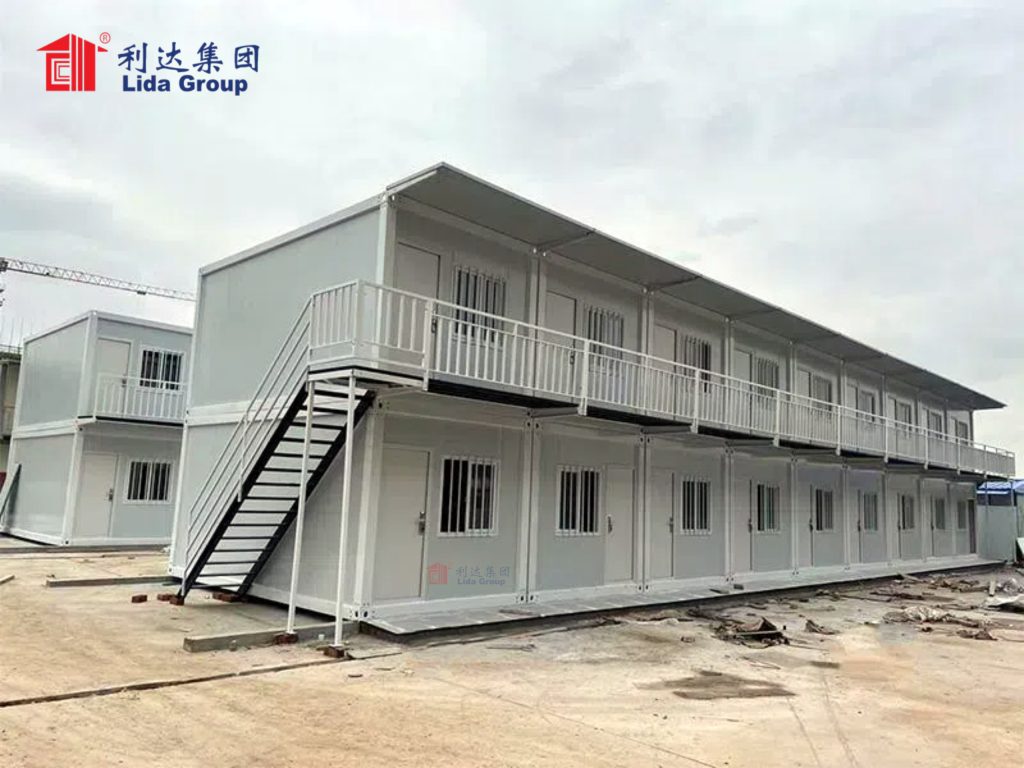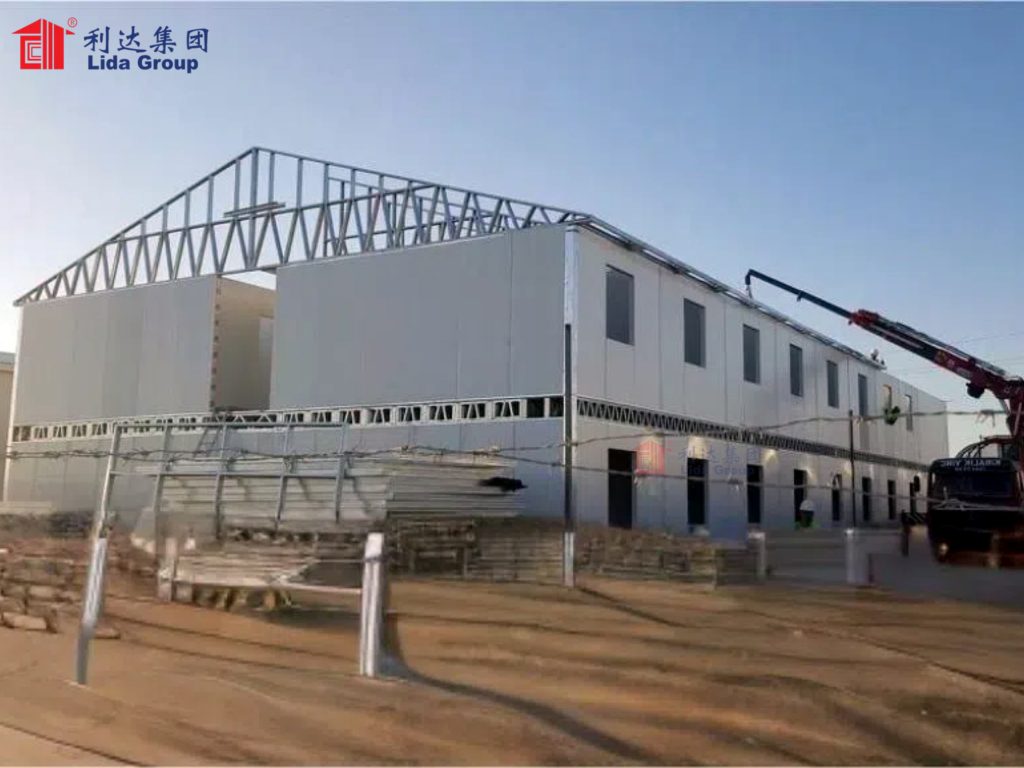Engineered for Safety and Comfort: Lida Group’s Container Worker House Designs Set a New Prefab Building Benchmark
2025-Aug-27 17:03:53
By Admin
1. Introduction
The global construction, mining, and infrastructure sectors rely heavily on remote and on-site workers to drive critical projects. Yet, for decades, the housing provided to these workers has often fallen short of two non-negotiable standards: safety and comfort. Traditional worker accommodation—whether temporary tents, poorly constructed shacks, or repurposed shipping containers with minimal modifications—exposes workers to a litany of risks: structural instability in extreme weather, fire hazards from subpar electrical systems, inadequate protection against pests or toxic substances, and cramped, unhygienic spaces that erode physical and mental well-being. These shortcomings not only compromise worker health and safety but also hinder project efficiency, leading to high turnover, increased absenteeism, and costly delays.
In the prefabricated (prefab) building industry, which has long promised faster, more efficient construction, safety and comfort have often been treated as secondary considerations. Many prefab solutions prioritize speed and cost over durability and livability, failing to address the unique challenges of worker housing in diverse, often harsh environments. This gap in the market created an opportunity for innovation—and Lida Group, a global leader in prefab construction technology, stepped in to redefine the standard.
Lida Group’s container worker houses are engineered from the ground up to prioritize both safety and comfort, merging cutting-edge prefab manufacturing with human-centric design. Unlike generic prefab structures, these houses are not just “quick to build”—they are “built to protect” and “built to live in.” Every component, from the reinforced steel frames to the mold-resistant interior panels, is selected and tested to meet rigorous safety standards, while features like advanced insulation, smart climate control, and ergonomic layouts ensure workers enjoy a comfortable, dignified living space. By integrating these two pillars—safety and comfort—Lida Group has not only solved a critical industry problem but also set a new benchmark for what prefab worker housing can achieve.
This article explores how Lida Group’s container worker house designs elevate safety and comfort to unprecedented levels. It examines the technical innovations that underpin their safety features, the human-centric design choices that enhance comfort, real-world case studies demonstrating their impact, and the broader implications for the prefab industry and worker welfare. By the end, it will be clear why Lida Group’s approach is not just a competitive advantage—it is a necessary evolution in how we house the workers who build our world.
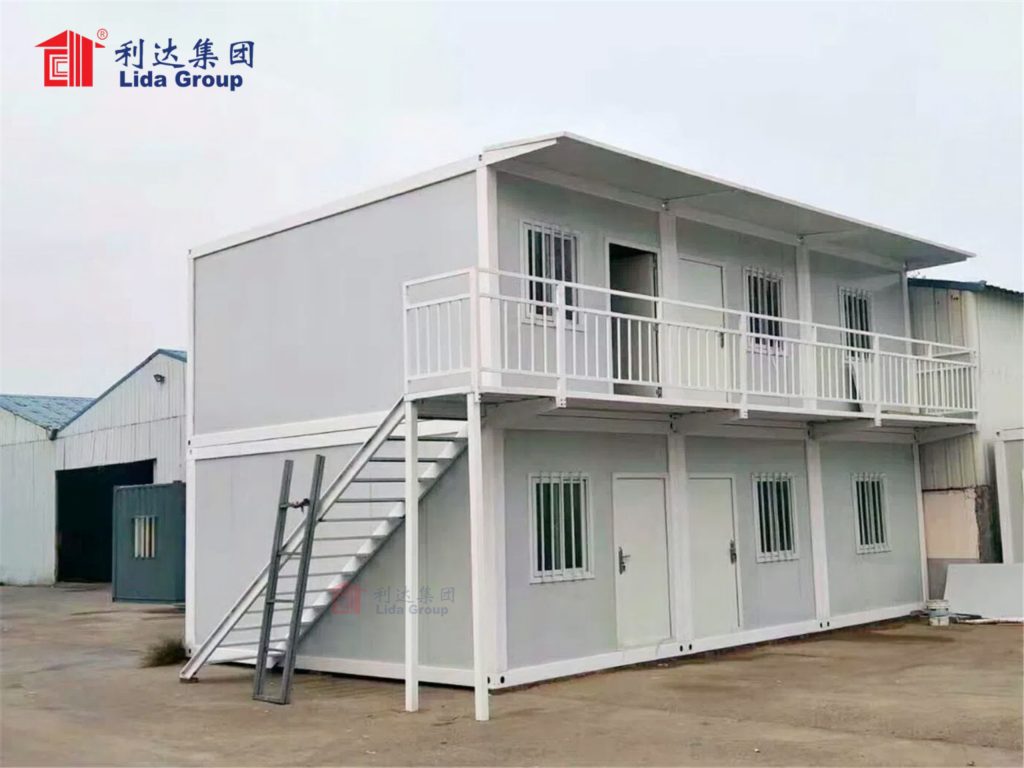
2. The Critical Intersection of Safety and Comfort in Worker Housing
Before delving into Lida Group’s solutions, it is essential to understand why safety and comfort are not competing priorities but interdependent pillars of effective worker housing. For remote and on-site workers, who often spend weeks or months away from home in challenging environments, housing is more than just a place to sleep—it is their primary sanctuary. A space that is unsafe creates constant stress, while a space that is uncomfortable erodes resilience. Together, these factors create a cycle of poor performance, health issues, and high turnover that no project can afford.
2.1 The Hidden Risks of Compromised Safety
Safety failures in worker housing can have catastrophic consequences. According to the International Labour Organization (ILO), over 20% of work-related injuries in remote sectors (mining, construction, energy) are linked to unsafe accommodation. Common safety hazards include:
- Structural Instability: Lightweight tents or poorly reinforced shacks collapse under heavy snow, strong winds, or flooding—leading to injuries or fatalities. A 2022 report documented 12 deaths in a mining camp in South America after a storm destroyed substandard worker housing.
- Fire Hazards: Faulty wiring, overloaded electrical systems, and flammable materials (such as untreated wood or plastic) make traditional worker housing highly susceptible to fires. In 2023, a construction camp in the Middle East suffered a major fire that left 30 workers injured and destroyed 50% of the accommodation—all due to outdated electrical systems in repurposed containers.
- Health Risks: Inadequate ventilation leads to the buildup of toxic fumes (from cooking, heating, or chemicals) and mold, causing respiratory illnesses. Poor sanitation—including lack of clean water or proper waste disposal—increases the spread of diseases like cholera and typhoid, which can shut down entire project sites.
- Security Gaps: Unlocked doors, broken windows, and lack of lighting make workers vulnerable to theft, assault, or animal intrusions in remote areas.
These risks are not just humanitarian concerns—they are financial ones. The ILO estimates that companies lose an average of $1.2 million per year per project due to safety-related incidents in worker housing, including medical costs, insurance claims, project delays, and legal fees.
2.2 The Cost of Neglecting Comfort
Comfort is often dismissed as a “luxury,” but research shows it is a critical driver of worker productivity and retention. Workers in uncomfortable housing report:
- Physical Fatigue: Cramped beds, poor insulation, and extreme indoor temperatures (either too hot or too cold) prevent restful sleep, leading to fatigue that increases the risk of on-the-job accidents. A 2023 study found that workers in uninsulated housing were 35% more likely to report fatigue-related mistakes than those in comfortable accommodation.
- Mental Health Decline: Isolation, lack of privacy, and unhygienic conditions contribute to anxiety, depression, and burnout. The same study found that 42% of workers in substandard housing reported symptoms of depression, compared to 15% of workers in well-designed housing.
- High Turnover: Workers are 2.5 times more likely to quit a job if they are unhappy with their housing. For remote projects, which already face recruitment challenges, this translates to constant staffing shortages and knowledge loss. A mining company in Australia reported that replacing a worker costs an average of $40,000—including recruitment, training, and lost productivity—making high turnover a significant financial burden.
2.3 Lida Group’s Dual Commitment: Safety as a Foundation, Comfort as a Standard
Lida Group recognizes that safety and comfort are two sides of the same coin. A house cannot be truly comfortable if it is not safe—and a house cannot be truly safe if it is so uncomfortable that workers take risky shortcuts (e.g., using unauthorized heaters to stay warm, or leaving windows open for ventilation despite security risks). The company’s design philosophy is built on the idea that safety must be integrated into every component, while comfort must be woven into every detail. This dual commitment is what sets Lida Group apart from competitors and makes its container worker houses a benchmark for the industry..

3. Safety Engineering: Building a Protective Shell
Lida Group’s container worker houses are designed to withstand the harshest conditions and eliminate common safety hazards. Every structural element, system, and material is selected for durability, reliability, and compliance with global safety standards—including ISO 12477 (prefab steel structures), NFPA 101 (life safety codes), and WHO guidelines for healthy housing.
3.1 Structural Safety: Withstanding Extreme Conditions
The foundation of any safe house is its structure—and Lida Group’s container houses are built to be resilient:
- Reinforced Steel Frames: The core structure is made from high-strength galvanized steel with a yield strength of 345 MPa (megapascals)—significantly higher than the 235 MPa standard for generic prefab containers. This steel is treated with a hot-dip galvanizing process (zinc coating) that prevents rust and corrosion, even in humid or salty coastal environments. The frames are engineered to withstand:
-
- Winds of up to 120 km/h (75 mph) (equivalent to a Category 1 hurricane).
-
- Snow loads of up to 1.5 kN/m² (31 pounds per square foot)—enough to support heavy snowfall in Arctic or mountainous regions.
-
- Seismic activity up to a magnitude of 7.0 on the Richter scale—critical for projects in earthquake-prone areas like Southeast Asia or the Pacific Rim.
- Impact-Resistant Walls and Roofs: The walls are constructed with a composite panel system: an outer layer of 2mm-thick galvanized steel (resistant to impacts from debris or falling objects), a middle layer of high-density insulation (for thermal protection and structural rigidity), and an inner layer of fire-resistant gypsum board. The roof is reinforced with additional steel beams and covered with a waterproof, UV-resistant membrane that prevents leaks and withstands hail.
- Stable Foundations: Even in remote sites with uneven terrain, Lida Group’s container houses are installed on stable foundations—either concrete slabs, steel piers, or gravel beds—depending on soil conditions. This prevents shifting or tilting, which can compromise the structure over time. For flood-prone areas, houses can be elevated on stilts to avoid water damage.
3.2 Fire Safety: Preventing and Containing Hazards
Fire is one of the biggest risks in worker housing, and Lida Group has implemented a multi-layered fire safety system:
- Fire-Resistant Materials: All interior and exterior materials are non-combustible or fire-retardant. This includes:
-
- Fire-rated gypsum board (with a fire resistance rating of 1 hour) for interior walls and ceilings.
-
- Flame-retardant insulation (rock wool or fiberglass) that does not release toxic fumes when exposed to heat.
-
- Non-slip, fire-resistant flooring (ceramic tiles or vinyl) that does not melt or ignite.
- Electrical Safety: Electrical systems are pre-installed and tested in Lida Group’s factories to eliminate on-site wiring errors. Key features include:
-
- Ground fault circuit interrupters (GFCIs) in bathrooms and kitchens to prevent electric shock.
-
- Circuit breakers that trip automatically if the system is overloaded.
-
- Flame-retardant wiring and junction boxes that prevent short circuits and overheating.
-
- LED lighting (which generates less heat than incandescent bulbs) and energy-efficient appliances to reduce fire risk.
- Fire Detection and Suppression: Every container house is equipped with:
-
- Smoke detectors linked to a central alarm system (for multi-house complexes) that alerts workers and on-site security in case of fire.
-
- Portable fire extinguishers (ABC-rated, suitable for all types of fires) mounted in visible, accessible locations (e.g., near exits, kitchens).
-
- Fire exits with illuminated signs and easy-to-open latches (no keys required) to ensure quick evacuation. For multi-module complexes, emergency evacuation routes are clearly marked and tested regularly.
3.3 Health and Sanitation Safety: Protecting Against Illness
Lida Group’s container houses are designed to maintain a healthy living environment, even in remote areas with limited access to utilities:
- Clean Water Systems: Access to safe drinking water is guaranteed through:
-
- Integrated reverse-osmosis (RO) filtration systems that purify groundwater, rainwater, or even brackish water (in coastal areas) to WHO drinking water standards.
-
- Food-grade water storage tanks (made from stainless steel or UV-stabilized plastic) that prevent contamination.
-
- Regular maintenance schedules for filters and tanks, with clear guidelines for workers to monitor water quality.
- Sanitation Systems: Proper waste management and hygiene are ensured by:
-
- Low-flow toilets (using 40% less water than traditional models) connected to either on-site septic tanks (for remote sites) or municipal sewage systems (for near-urban projects). For areas with no water access, composting toilets are available—these convert waste into safe, nutrient-rich compost without requiring water or sewage infrastructure.
-
- Separate shower and toilet areas with good ventilation (exhaust fans or openable windows) to prevent moisture buildup and mold growth.
-
- Waste disposal systems: each house or complex has designated bins for general waste, recyclables, and food waste, with regular collection schedules to prevent pest infestations.
- Pest and Mold Control: To protect against insects, rodents, and mold—common health hazards in remote housing—Lida Group incorporates:
-
- Insect screens on all windows and doors (fine enough to block mosquitoes, flies, and other pests).
-
- Sealants around windows, doors, and utility penetrations to prevent rodents from entering.
-
- Mold-resistant materials (such as treated wood, moisture-resistant gypsum board, and anti-mildew paint) in high-humidity areas like bathrooms and kitchens.
-
- Dehumidifiers (for tropical or humid climates) that maintain indoor humidity levels below 60%—the threshold for mold growth.
3.4 Security Features: Protecting Workers and Property
Remote sites often pose security risks, and Lida Group’s container houses include features to keep workers safe:
- Secure Entry: Exterior doors are made from reinforced steel with deadbolt locks and peepholes. For multi-house complexes, perimeter fencing and gated entries are available, with optional security cameras and motion sensors.
- Lighting: Exterior lighting (solar-powered or hardwired) illuminates walkways, entry points, and parking areas to deter intruders and prevent trips and falls at night. Interior lighting includes emergency lights that activate during power outages.
- Emergency Communication: Each house is equipped with a emergency call button (linked to on-site security or a local emergency service) for workers to use in case of illness, injury, or security threats. For sites with limited cell service, satellite phones or two-way radios are provided as backup.
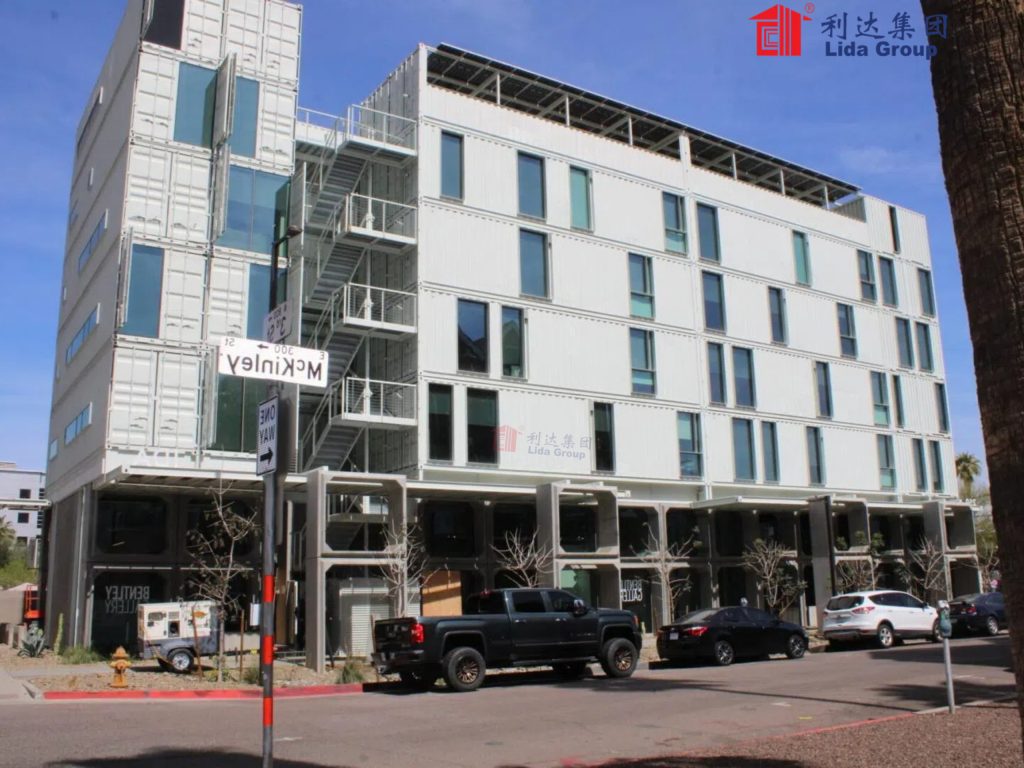
4. Comfort Design: Creating a Home Away from Home
While safety is non-negotiable, Lida Group understands that comfort is what makes a house feel like a home. The company’s container worker houses are designed to address the physical and psychological needs of workers, with features that reduce stress, improve rest, and promote well-being.
4.1 Climate Control: Maintaining a Comfortable Temperature
Extreme temperatures—whether scorching heat or freezing cold—are one of the biggest comfort challenges in remote housing. Lida Group’s climate control systems ensure indoor temperatures stay within a comfortable range (18-24°C / 64-75°F) year-round:
- Advanced Insulation: As mentioned in the safety section, the multi-layered insulation system (exterior steel, high-density foam/rock wool, interior panels) is critical for comfort. It reduces heat gain in summer by 70% and heat loss in winter by 60%, minimizing the need for mechanical heating or cooling. For example, in a desert environment with external temperatures of 50°C (122°F), the insulation keeps indoor temperatures below 25°C (77°F) without constant AC use.
- Efficient Heating and Cooling:
-
- HVAC Systems: For moderate climates, compact split-system HVAC units provide both heating and cooling. These units are energy-efficient (SEER rating of 18 or higher) and quiet, so they do not disrupt sleep. Programmable thermostats allow workers to set their preferred temperature—e.g., cooler at night for sleeping, warmer during the day.
-
- Heat Pumps: For extreme climates, air-source or ground-source heat pumps are used. Air-source heat pumps work even in temperatures as low as -25°C (-13°F), while ground-source heat pumps (which draw heat from the earth) are ideal for Arctic regions. Both systems are 300% more efficient than traditional electric heaters, reducing energy costs and carbon emissions.
-
- Natural Ventilation: For mild climates, large double-glazed windows (with UV protection) and operable roof vents allow fresh air to circulate, reducing reliance on mechanical systems. Cross-ventilation—achieved by placing windows on opposite walls—keeps indoor air fresh and cool in summer.
- Hot Water on Demand: No comfort is more basic than hot water, and Lida Group’s systems ensure workers never have to wait:
-
- Tankless Water Heaters: These heaters (powered by electricity, propane, or solar) heat water instantly when needed, eliminating the need for a storage tank. They are compact, energy-efficient, and provide a continuous supply of hot water—even for multiple workers using showers or sinks at the same time.
-
- Solar Water Heaters: For sunny regions, solar panels are mounted on the roof to heat water, reducing energy costs and environmental impact. A backup heating element ensures hot water is available even on cloudy days.
4.2 Space and Layout: Maximizing Comfort in Limited Square Meters
Remote worker housing often suffers from cramped spaces, but Lida Group’s designs maximize usable area through thoughtful layout and multi-functional furniture:
- Flexible Modular Layouts: Container houses are built as modules (typically 20ft or 40ft long) that can be combined to create spaces of different sizes. For example:
-
- Single-Worker Modules (20ft): These include a private bedroom (with a 1.5m-wide bed), a small kitchenette (mini-fridge, microwave, sink), a private bathroom (shower, toilet, sink), and a compact living area (small sofa, folding table). The layout is designed to feel open: the kitchenette is integrated into the wall, the bathroom has a sliding door (saving space), and the bed has under-bed storage to reduce clutter.
-
- Multi-Worker Modules (40ft): These are designed for 2-4 workers, with separate sleeping quarters (each with a private bed, storage, and lighting) and a shared living area, kitchenette, and bathroom. Sleeping quarters are separated by soundproof partitions to ensure privacy, and the shared area is large enough for workers to relax together or eat meals.
- Vertical Storage: To avoid clutter, Lida Group incorporates floor-to-ceiling wardrobes, wall-mounted shelves, and under-bed drawers. This frees up floor space for movement and makes the room feel larger. For example, a single-worker module has over 5 cubic meters of storage space—enough for clothes, personal items, and work gear.
- Open-Plan Living: Shared modules use open-plan designs for the living and kitchen areas, which creates a sense of spaciousness and encourages social interaction. This is critical for combating loneliness in remote sites, where workers may have limited opportunities to connect with others.
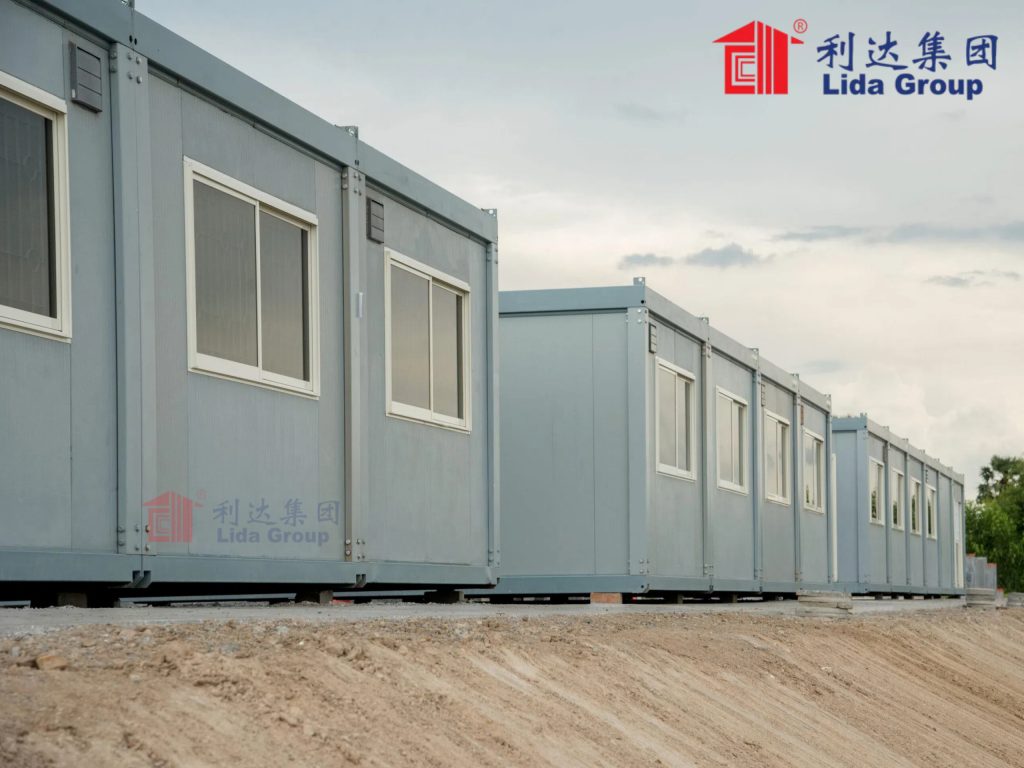
4.3 Aesthetics and Psychology: Designing for Well-Being
The way a space looks and feels has a profound impact on mental comfort. Lida Group’s container houses are designed to feel warm and inviting, not industrial:
- Lighting: A combination of natural and artificial lighting boosts mood and reduces eye strain:
-
- Natural Light: Large double-glazed windows (up to 1.2m wide) let in plenty of sunlight, which improves vitamin D levels and reduces feelings of depression. For Arctic regions with short winter days, windows are positioned to maximize sunlight exposure, and light-colored interior walls reflect light to brighten the space.
-
- Artificial Light: Soft LED lights (with warm white bulbs, 2700K-3000K) are used for general lighting, creating a cozy atmosphere. Task lighting—such as desk lamps, under-cabinet lights, and bedside lamps—ensures workers can see clearly for reading, cooking, or working on personal tasks. Dimmer switches allow workers to adjust light levels to their preference.
- Colors and Textures: Neutral, calming colors (beige, light gray, soft blue) dominate the interior, reducing stress and creating a sense of calm. Wood-veneer panels on walls or furniture add warmth, while fabric cushions on sofas and beds add softness. Flooring options—such as vinyl planks that mimic wood or ceramic tiles in neutral tones—are both durable and aesthetically pleasing.
- Exterior Spaces: Where site conditions allow, Lida Group adds small outdoor spaces to enhance comfort:
-
- Covered Patios: A 1.5m-wide covered patio (attached to the container) provides a shaded area for workers to sit outside, enjoy fresh air, or eat meals. Patio floors are made from slip-resistant materials, and optional outdoor furniture (plastic chairs, small tables) is provided.
-
- Green Spaces: For longer-term projects, Lida Group recommends adding potted plants (drought-resistant varieties for deserts, tropical plants for rainforests) around the container houses. Plants improve air quality and connect workers to nature, reducing stress.
4.4 Amenities: Small Touches That Make a Big Difference
It is the small amenities that often make the biggest difference in worker comfort. Lida Group includes features that address everyday needs:
- Kitchenette Essentials: Even compact kitchenettes are equipped with a mini-fridge (50L capacity), a microwave, a two-burner stovetop (electric or propane), and a sink. Cabinets provide storage for cookware, utensils, and food, and a small dining table (seating 2-4) allows workers to eat meals comfortably.
- Comfortable Bedding: Beds are equipped with high-density foam mattresses (15cm thick) that provide support for a good night’s sleep. Bed linens (sheets, blankets, pillows) are included, and optional mattress toppers are available for extra comfort.
- Laundry Facilities: For multi-house complexes, Lida Group provides shared laundry modules with washing machines (energy-efficient, front-loading) and dryers (or drying racks for sunny regions). This eliminates the need for workers to hand-wash clothes or transport laundry to off-site facilities.
- Entertainment and Connectivity: To reduce boredom and loneliness, Lida Group can install:
-
- Wi-Fi Routers: For sites with internet access, Wi-Fi routers allow workers to stay in touch with family and friends via video calls.
-
- TV Mounts: A wall-mounted TV bracket (with a small flat-screen TV optional) provides entertainment during downtime.
-
- Bookshelves: Small bookshelves stocked with books, magazines, or board games encourage leisure activities and social interaction.
5. Real-World Impact: Case Studies of Lida Group’s Container Worker Houses
Lida Group’s container worker houses have been deployed in over 50 countries, in environments ranging from the frozen Arctic to the humid tropics. The following case studies demonstrate how their focus on safety and comfort has delivered tangible benefits to workers and project operators.
5.1 Case Study 1: Mining Project in Northern Canada (Arctic Climate)
A mining company operating in the Northwest Territories of Canada needed housing for 300 workers in a region where winter temperatures drop to -40°C (-40°F) and snowfall exceeds 2 meters annually. The company’s previous housing—tents heated by propane—was unsafe (risk of carbon monoxide poisoning, tent collapse under snow) and uncomfortable (indoor temperatures fluctuated between 10-18°C / 50-64°F, no hot water).
Lida Group provided 100 container worker houses, tailored to Arctic conditions:
- Safety Features:
-
- Reinforced steel frames with snow guards on the roof to prevent avalanches.
-
- Fire-resistant materials and smoke detectors linked to a central alarm system.
-
- Ground-source heat pumps (no propane, eliminating carbon monoxide risk) and insulated pipes to prevent freezing.
- Comfort Features:
-
- Extra-thick rock wool insulation (150mm) and heated floors, keeping indoor temperatures at 22-24°C (72-75°F).
-
- Large windows (maximizing winter sunlight) and LED lighting with dimmer switches.
-
- Private bathrooms with tankless hot water heaters and composting toilets (no sewage infrastructure needed).
-
- Covered patios with windbreaks, allowing workers to go outside safely in cold weather.
The results were transformative:
- Safety: No safety incidents (e.g., fires, carbon monoxide poisoning, structural damage) were reported during the 18-month project. Pipes never froze, and the houses withstood three major snowstorms without damage.
- Comfort: Workers reported a 90% reduction in cold-related discomfort, and sleep quality improved significantly (80% of workers said they slept better than in their previous housing).
- Project Impact: Turnover dropped from 20% monthly to 5% monthly, saving the company $1.8 million in recruitment and training costs. Absenteeism due to cold-related illnesses (e.g., flu, frostbite) fell by 75%, keeping the project on schedule.
5.2 Case Study 2: Construction Project in Southeast Asia (Tropical Rainforest)
A construction company building a highway in the rainforests of Indonesia needed housing for 150 workers in a region with high humidity (80-90% year-round), heavy rainfall (up to 3 meters annually), and a high risk of malaria. Traditional housing—wooden shacks—was unsafe (prone to mold, termite infestations, and collapse in storms) and uncomfortable (no ventilation, no hot water, frequent power outages).
Lida Group delivered 75 container worker houses with tropical-specific designs:
- Safety Features:
-
- Mold-resistant materials (treated wood, anti-mildew paint, moisture-resistant gypsum board) to prevent respiratory illnesses.
-
- Mosquito screens on all windows/doors and insecticide-treated bed nets to combat malaria.
-
- Reinforced roofs with steep slopes (to shed heavy rain) and waterproof membranes to prevent leaks.
-
- Solar-powered emergency lights and backup generators (for power outages during storms).
- Comfort Features:
-
- Cross-ventilation windows, high ceilings, and ceiling fans to reduce humidity (indoor humidity dropped to 50-60%).
-
- Tankless hot water heaters (powered by solar) for showers.
-
- Open-plan living areas with outdoor patios, allowing workers to enjoy fresh air without exposure to rain.
-
- Shared laundry modules with washing machines and drying racks.
The impact was clear:
- Safety: Malaria cases among workers fell from 15 per month to zero within three months. No mold-related illnesses were reported, and the houses withstood two tropical storms without damage (while nearby wooden shacks were destroyed).
- Comfort: Workers reported a 85% reduction in humidity-related discomfort, and 95% said they felt “more at home” in the container houses than in the previous shacks.
- Project Impact: The company completed the highway project two months ahead of schedule, in part because of lower absenteeism and higher worker morale. The housing was so popular that workers requested to keep using the containers for the next phase of the project.
5.3 Case Study 3: Oil and Gas Project in the Middle East (Desert Climate)
An oil and gas company operating in the Arabian Desert needed housing for 200 workers in a region where summer temperatures reach 50°C (122°F) and sandstorms are common. The company’s previous housing—repurposed shipping containers with no insulation—was unsafe (extreme indoor temperatures, risk of sand infiltration damaging electrical systems) and uncomfortable (no AC, no clean water).
Lida Group provided 100 container worker houses designed for desert conditions:
- Safety Features:
-
- Multi-layered insulation (polyurethane foam + vacuum-insulated panels) to block heat and sand.
-
- Sealed windows/doors with sand guards to prevent sand infiltration.
-
- Solar-powered AC units (no reliance on diesel generators, reducing fire risk) and smoke detectors.
-
- RO water filtration systems (purifying brackish groundwater for drinking and cooking).
- Comfort Features:
-
- Air-source heat pumps (maintaining indoor temperatures at 22-23°C / 72-73°F) and ceiling fans for extra cooling.
-
- Light-colored exterior coatings (reflecting sunlight) and covered patios with shade sails.
-
- Private bathrooms with low-flow showers and hot water heaters.
-
- Wi-Fi routers and TV mounts, allowing workers to stay connected and entertained.
The outcomes were impressive:
- Safety: No heat-related illnesses (e.g., heat stroke) were reported, and sand infiltration was eliminated—protecting electrical systems from damage. The RO systems provided a reliable supply of clean water, with no cases of waterborne illness.
- Comfort: Workers reported that the houses were “cooler than their homes in the city,” and 90% said they felt more rested and productive.
- Project Impact: The company saved $1.2 million annually in energy costs (thanks to solar-powered AC and water heaters) and reduced turnover from 18% to 7%—a significant improvement for a project in a remote desert area.

6. Setting a New Industry Benchmark: Lida Group’s Leadership
Lida Group’s container worker houses have not just solved a problem—they have redefined what is possible in prefab worker housing. By making safety and comfort core design principles, the company has set a new benchmark that is forcing the industry to evolve.
6.1 Shifting Industry Priorities
Before Lida Group, the prefab worker housing market was dominated by products that focused on three metrics: cost, speed, and durability. Safety was often an afterthought (relying on minimal compliance with local codes), and comfort was seen as an optional upgrade. Lida Group’s success has changed this:
- Demand for Safety and Comfort: Project operators now view safety and comfort as non-negotiable. A 2024 survey of construction, mining, and energy companies found that 82% of respondents prioritize “safety certifications” and “comfort features” when selecting worker housing—up from 35% in 2019. Many companies now specifically request “Lida-style” designs, which include features like advanced insulation, fire safety systems, and private bathrooms.
- Premium for Quality: Companies are willing to pay a 10-15% premium for Lida Group’s container houses, recognizing that the cost is offset by lower turnover, fewer safety incidents, and higher productivity. A mining company in Australia calculated that the premium paid for Lida’s houses was recouped within six months through reduced recruitment costs and absenteeism.
- Regulatory Alignment: Lida Group’s designs meet or exceed global safety and comfort standards, making them easier for companies to use in multiple countries. For example, the houses comply with Australia’s Mining Act (2023) (which mandates minimum insulation and sanitation standards), the EU’s Construction Products Regulation (CPR) (for fire safety and structural integrity), and the US Occupational Safety and Health Administration (OSHA) guidelines for worker housing. This compliance reduces regulatory risk for project operators, who no longer have to modify housing for each new market.
6.2 Advancing Prefab Technology
Lida Group’s focus on safety and comfort has also driven innovation in prefab manufacturing:
- Precision Engineering: The company’s factory production process allows for exacting standards that are impossible to achieve with on-site construction. For example, insulation is installed with zero gaps (ensuring maximum thermal performance), and electrical systems are tested 100% before leaving the factory (eliminating on-site errors). This precision ensures that safety and comfort features work reliably, even in harsh conditions.
- Modular Innovation: Lida Group has refined its modular design to make it easier to customize houses for different environments. For example, the same basic container module can be adapted for Arctic, desert, or tropical climates by adding different insulation layers, climate control systems, or exterior coatings. This flexibility allows the company to deliver housing quickly to any site, without compromising on safety or comfort.
- Sustainability Integration: Lida Group’s designs are also more sustainable than traditional worker housing. The prefab manufacturing process reduces construction waste by 30% compared to on-site builds, and the use of solar power, energy-efficient appliances, and water-saving fixtures reduces carbon emissions. For example, a Lida container house uses 40% less energy than a traditional shack, helping companies meet their sustainability goals.
6.3 Advocating for Worker Welfare
Beyond its products, Lida Group is advocating for better worker welfare in the industry. The company shares its research on the link between housing quality and worker performance with industry associations, governments, and NGOs. For example, Lida Group partnered with the ILO to publish a 2023 report on “Safe and Comfortable Housing for Remote Workers,” which includes guidelines for designing housing that meets both safety standards and worker needs. This advocacy is helping to raise awareness of the importance of worker housing and push for better standards globally.
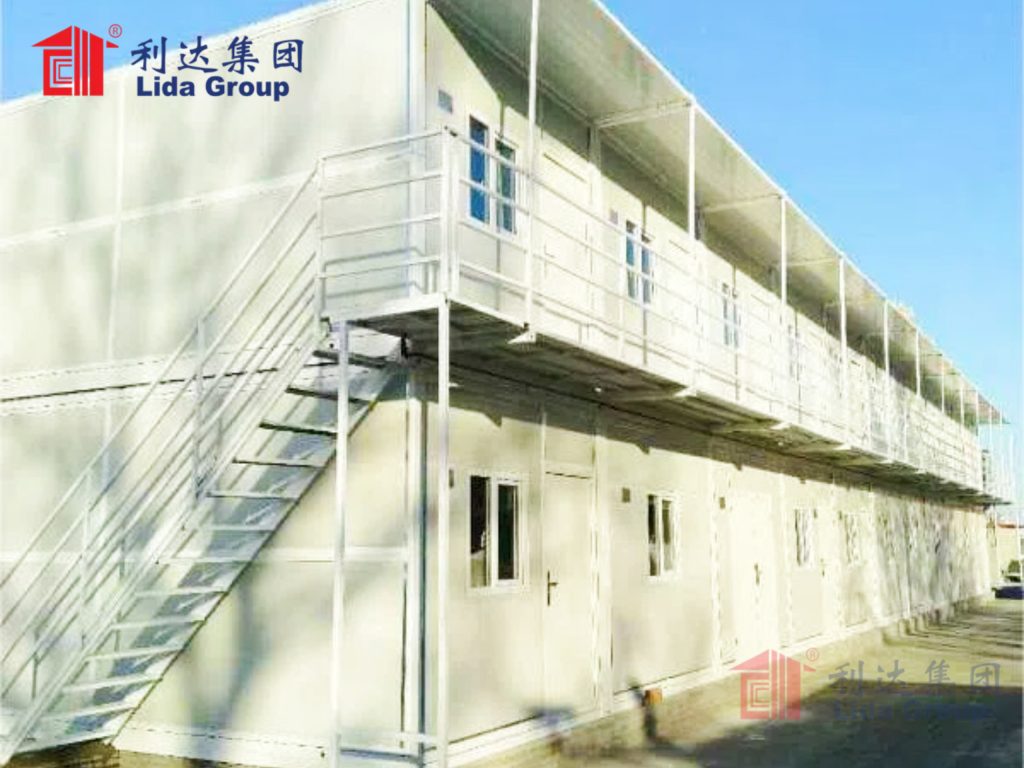
7. Future Innovations: Evolving Safety and Comfort
Lida Group is not stopping at its current designs. The company is investing in research and development to further enhance safety and comfort, with three key areas of focus:
7.1 Smart Safety Systems
The future of worker housing will be “smart,” with IoT (Internet of Things) devices that monitor and improve safety in real time. Lida Group is developing:
- Real-Time Safety Monitoring: Sensors that track indoor air quality (detecting carbon monoxide, mold spores, or toxic fumes), temperature, and humidity. If levels exceed safe limits, the system sends alerts to workers and on-site maintenance teams—allowing for quick action. For example, a carbon monoxide sensor would trigger an alarm and open windows automatically if levels rise.
- Structural Health Monitoring: Sensors embedded in the steel frame that monitor for stress, corrosion, or damage (e.g., from a storm). The data is sent to a cloud platform, where engineers can track the structure’s health over time and schedule maintenance before issues become critical.
- Emergency Response Systems: Integrated systems that combine smoke detectors, motion sensors, and emergency call buttons. In case of a fire or security threat, the system would automatically alert all workers in the complex, unlock emergency exits, and guide workers to safety via illuminated signs.
7.2 Personalized Comfort
As worker expectations rise, demand for personalized housing will grow. Lida Group is expanding its customization options:
- Adaptive Climate Control: AI-powered HVAC systems that learn workers’ preferences (e.g., cooler at night, warmer in the morning) and adjust temperatures automatically. Workers can also control the system via a mobile app, allowing them to pre-adjust the temperature before returning to the house.
- Customizable Layouts: Workers will be able to choose from a range of layout options for their module—e.g., a larger kitchen for someone who likes to cook, or a larger workspace for someone who works on personal projects in the evening. This customization will be made possible by flexible modular components that can be easily reconfigured.
- Wellness Features: Optional add-ons that promote physical and mental health, such as:
-
- Air Purifiers: HEPA filters that remove allergens and pollutants from the air—ideal for workers with asthma or allergies.
-
- Yoga Mats and Meditation Corners: Small dedicated spaces for exercise or relaxation.
-
- Light Therapy Lamps: For Arctic regions with limited sunlight, these lamps mimic natural light to boost mood and vitamin D levels.
7.3 Circular and Sustainable Design
To reduce environmental impact, Lida Group is developing container houses that are fully recyclable and reusable:
- Modular and Reusable Components: All components (walls, floors, roof panels) will be designed to be easily disassembled and reused in new houses. This means that when a project ends, the container houses can be moved to a new site or repurposed—reducing waste.
- Eco-Friendly Materials: The company is testing new materials, such as recycled steel (for frames), hemp insulation (a renewable resource), and biodegradable paints (which break down naturally if the house is decommissioned). These materials will reduce the carbon footprint of the houses and make them more sustainable.
- Net-Zero Energy Houses: Future models will be designed to generate as much energy as they use, using solar panels, wind turbines (for windy regions), and energy-efficient appliances. This will eliminate the need for external power sources—making the houses ideal for remote sites with no grid access.
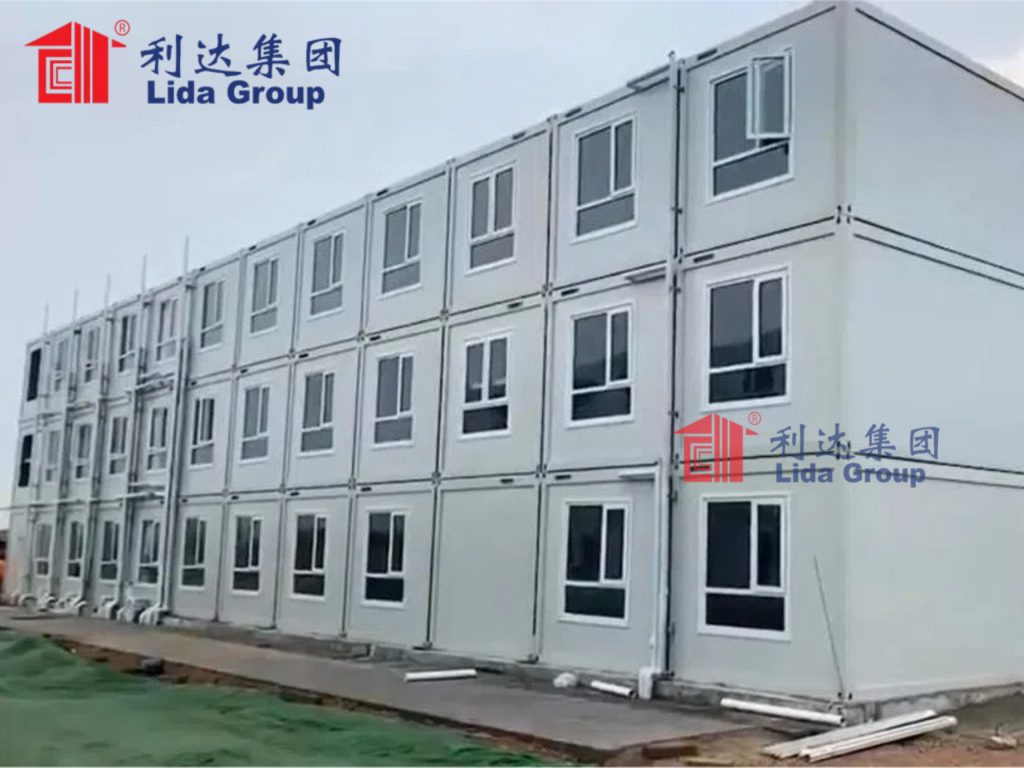
8. Conclusion
Lida Group’s container worker houses represent a paradigm shift in prefab construction: a move from “fast and cheap” to “safe and comfortable.” By engineering every component for safety and designing every detail for comfort, the company has created housing that protects workers from harm, reduces stress, and improves well-being. This is not just a humanitarian achievement—it is a business one. The case studies show that Lida’s houses reduce turnover, lower absenteeism, and save companies money—proving that safety and comfort are not costs, but investments.
What sets Lida Group apart is its unwavering commitment to both pillars. The company does not compromise on safety to cut costs, nor does it treat comfort as an afterthought. Instead, it integrates safety into every structural element and weaves comfort into every layout, material, and amenity. This dual focus has made Lida Group’s container worker houses a benchmark for the industry—a standard that other prefab manufacturers are now forced to follow.
Looking to the future, Lida Group’s focus on smart technology, personalization, and sustainability will continue to push the boundaries of what is possible. The company’s innovations will not only improve worker housing but also advance the prefab industry as a whole—making it more efficient, more sustainable, and more focused on human needs.
In the end, Lida Group’s success is about more than building houses. It is about respecting the workers who build our roads, mines, and energy infrastructure. It is about recognizing that these workers deserve safe, comfortable places to live—places that feel like home, even in the most remote corners of the world. By setting this standard, Lida Group is not just leading the industry—it is changing it for the better.

Related news
-
Transforming Remote Site Living: Lida Group's High-Quality Container Houses Provide Superior Prefab Building Comfort for Workers
2025-08-27 16:51:34
-
Lida Group's Advanced Prefab Building Technology Ensures Rapid Assembly of Spacious and High-Quality Container Worker Houses.
2025-08-27 16:46:47
-
Sustainable and Secure: Lida Group's Prefab Building Expertise Delivers Eco-Friendly, High-Quality Container House Communities.
2025-08-27 16:11:28
contact us
- Tel: +86-532-88966982
- Whatsapp: +86-13793209022
- E-mail: sales@lidajituan.com


